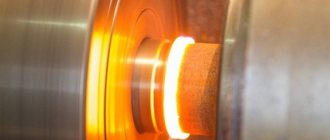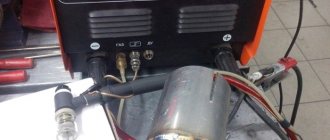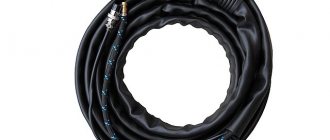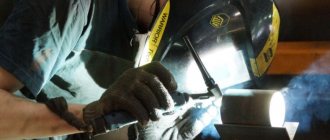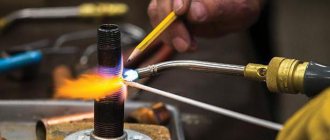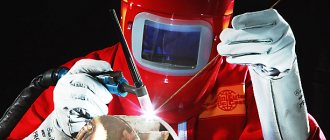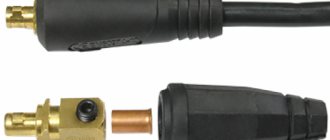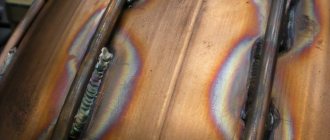When welding metal structures and other metal products, the gas shielded welding . carbon dioxide is used as a gas , which effectively displaces atmospheric air from the metal melting zone.
Carbon dioxide welding technology was developed by Soviet scientists in the 50s of the 20th century.
For carbon dioxide welding, semi-automatic welding machines or automatic welding lines are used The review will discuss how to work with welding in carbon dioxide.
Carbon dioxide welding is applicable for the following metals:
- Cast iron
- Low and medium carbon steel
- Corrosion resistant low alloy steel
It should be immediately noted that carbon dioxide welding is not suitable for working with alloyed stainless steel, refractory high-strength alloys, and copper. The fact is that carbon dioxide enters into a chemical reaction with many metals and alloys, making the welding seam substandard.
What you need to know about carbon dioxide welding.
What is carbon dioxide
The possibility of using carbon dioxide as a protective medium is due to the increased density of carbon dioxide . Carbon dioxide is 1.5 times heavier than atmospheric air. This property allows carbon dioxide to easily displace air from the metal melting zone , the presence of which leads to the appearance of serious defects in the weld.
Carbon dioxide has the formula CO2 . As is clear, oxygen is present in the compound, which makes the reaction when melting the metal oxidative . To prevent oxidation of the molten metal, manganese (Mn) and silicon (Si) are introduced into the welding wire .
Auxiliary additives are the first to react with oxygen. Oxygen simply does not reach the molten metal.
To weld classic carbon steel, wire with an increased concentration of additives is used. To obtain a high-quality welding seam, it is very important to choose the right wire.
The main advantage of carbon dioxide is its affordable price . Carbonic acid is produced by reacting calcium carbonate with many acids. Carbon dioxide appears as a volatile compound that is collected and compressed by pressure. The output is liquefied carbon dioxide .
Carbon dioxide is stored in cylinders of 40-50 (l) under a pressure of 60 (atm). CO2 cylinders are painted black. For the inscription “carbon dioxide” a yellow color is used.
How to work with carbon dioxide welding.
Selection and maintenance of storage containers. Equipment
The choice of container volume is determined by the needs of the customer. Cylinders with low values are used for domestic needs and simple short-term construction. Large containers are designed specifically for stationary use in factories and enterprises, and are not intended for frequent movements and transportation. Small containers are not equipped with valves. Medium-sized cylinders can be equipped and completed with:
- Shoes
- Valves
- Rings
- Caps
At the customer's request, containers for storing and transporting liquefied substances are made with neck dimensions different from the current GOST 949-73. New equipment, at the buyer's request, may not be painted by the manufacturer.
The completeness is indicated by the customer in a specific questionnaire. Equipment with additional parts is indicated in notes with justification. Standardly supplied with the cylinder:
- Neck ring
- shoe
- Flow valve
- Safety cap
The outer wall must be painted with black paint with the yellow inscription “Carbon Dioxide”. Every 5 years all equipment is subject to technical inspection.
Maintenance of equipment for the transportation and storage of carbon dioxide is carried out by organizations that have permission for this type of activity. Before putting into operation, all cylinders must be painted with enamel, oil or nitro paint. After the procedure, containers for carbon dioxide are marked according to the rules of the current GOST.
Carbon dioxide welding technology
Carbon dioxide is an active (oxidizing) gas. For this reason, the welding machine should be switched to MAG mode. Carbon dioxide welding uses direct current with reverse polarity .
If you use straight polarity for carbon dioxide welding, the seam joint will be defective.
The use of carbon dioxide allows the use of direct current with direct polarity, but on the condition that not welding is carried out, but metal deposition.
In some cases, it is permissible to use alternating current when welding with carbon dioxide. But to realize this possibility, the welding machine must be equipped with a stabilizing oscillator .
What is needed for carbon dioxide welding.
Application area
Shielding gas is used, as we have already said, in mechanized welding to protect the welding arc and melt from gases from the air. It is used in 80% of cases of semi-automatic welding, 20% of which are self-shielded flux-cored wire welding.
The scope of application is very wide since this process is simple and very productive. Semi-automatic welding is used to weld thin metal in car repair shops, because it is very problematic to weld thin metal by manual welding. It's easy to burn through. This is how they are used in the production of metal structures and large products.
There the situation is the opposite, the seams are long, and the thickness of the metal is large. It is used there because this process is very productive and welding long seams and thick metal by hand welding is expensive and time-consuming.
For the most part, the difference here will only be in the use of the devices themselves. In car service centers, cheap models are usually used, while in production they use expensive professional equipment with a synergetic control system that ensures high performance.
Design of a carbon dioxide welding machine
For manual welding, a semi-automatic welding machine is used to work in a shielding gas environment. The carbon dioxide welding installation includes:
- Semi-automatic welding
- Welding torch
- Liquefied carbon dioxide cylinder
- Connecting hoses
- Transport trolley
If the welding station is stationary, the kit may not be equipped with a trolley.
- Semi-automatic welding machines differ from simple welding machines by the presence of a wire feed mechanism. A semi-automatic machine is the same compact and lightweight inverter, only with a coil of wire inside.
The welding wire acts as a continuous electrode. Welding wire is sold in the form of a wound spool. When the wire runs out, the empty spool just needs to be replaced with a new spool. In this case, the free end of the wire should be inserted into the pulling mechanism.
- The welding torch provides the supply of wire and shielding gas. As is clear, the burner has 2 connection points. One is connected to a carbon dioxide cylinder, and the second to a semi-automatic device.
The first hose circulates carbon dioxide, and the second hose serves to transfer the welding wire.
When you press the button, wire and carbon dioxide are fed simultaneously. When the wire comes into contact with a metal surface, an arc occurs.
- The carbon dioxide cylinder is used to store a supply of protective gas.
If the welding station is stationary, then a full-size 40-50 (l) cylinder is usually used. For mobile installations, for on-site welding, compact CO2 cylinders are used. The volume of such cylinders is usually 20 (l).
The compact cylinder is easy to transport. For this purpose, a special place is provided in the cart.
- Connecting hoses are used to supply carbon dioxide and wire to the burner.
The sleeve for supplying the welding wire forms a single structure with the torch. The length of the hose for drawing wire usually does not exceed 1.5-2 meters.
A separate hose is used to connect the burner to the carbon dioxide cylinder.
It is worth noting that when carbon dioxide transitions from a liquid to a gaseous state, strong cooling occurs . The cooling temperature can reach –72 C. If you use a simple hose, it will simply become stiff.
After several cycles of freezing and thawing, a simple budget hose will become covered with cracks, which will gradually develop into through breakthroughs. When working with carbon dioxide, you should use a special hose that is not subject to freezing.
The hoses for connecting carbon dioxide cylinders are based on heat-resistant silicone. Such hoses are not afraid of either heating or freezing.
• The transport cart makes it possible to effortlessly transport everything needed for carbon dioxide welding in one go.
This cart provides space for a welding machine and a cylinder. Additionally, the trolley allows you to securely fix the torch, gloves and welding helmet .
How long do carbon dioxide cylinders of different sizes last?
As you know, a standard 40-liter cylinder contains 24 kg of CO2, which, when evaporated, forms about 12,000 dm³ of the gas phase. Taking into account the above data, it is possible to determine how long a carbon dioxide cylinder lasts during a continuous working process.
Here is an ordinary 40 liter cylinder filled with carbon dioxide
So, for example, when using a 1 mm wire and an average current of 100 A, 40 liters of gas will last approximately 24 hours. Accordingly, a 10 liter cylinder should be enough for 6 hours of continuous use.
According to reference materials, 1.1 kg of CO2 and 1.35 kg of welding wire are consumed per 1 kg of deposited metal. Thanks to these data, the following proportion is determined: CO2/wire = 1:1.2 kg. That is, for 1.2 kg of wire material there is 1 kg of carbon dioxide in the liquid phase.
Based on the obtained coefficient, you can easily calculate consumption: 24 kg of carbon dioxide (40 liter capacity) is enough for 29 kg of welding metal. As practice shows, these calculations correspond to reality in most cases.
What are the benefits of carbon dioxide welding?
- High quality welding seam
- High productivity of welding work
- Carbon dioxide availability
- Easy to store CO2 cylinders and safe to work with carbon dioxide
Carbon dioxide welding makes it possible to obtain a high quality weld seam . After all, during metal smelting, the melt does not react with either atmospheric air or oxygen, which is released when the gas is heated.
The welding seam is clean, free of sludge and other contaminants .
Carbon dioxide from cylinders is harmless to the human body. At least until it is heated to a high temperature when melting the metal.
Under normal conditions, CO2 can be used as a food additive. Carbon dioxide is mixed into drinking water. The result is classic soda.
This is interesting! Carbon dioxide has been used to carbonate drinking water and fruit juice since the 18th century.
Types of pneumatic cylinders
For shooting from foreign-made pneumatics, you should not use domestic cylinders, since the rubber seals and mechanisms of the weapon are designed for use with the cylinder manufacturer of the same name.
Today on sale you can find cans with:
- carbon dioxide;
- carbon dioxide 12 g + 10%;
- carbon dioxide and lubricant.
Popular manufacturers of gas cylinders are:
- Crosman;
- Umarex;
- Quart;
- Borner;
- Tulammo.
Gas cartridges with lubricant must be installed after shooting approximately 15 conventional cylinders, this is indicated by the pneumatic manufacturer in the operating instructions. Reinforced cartridges from the Russian company Tulammo can be used for pneumatic weapons produced by the Izhevsk plant.
To fire a shot, the pistol is connected to the gas composition by a special mechanism through which carbon dioxide passes; it contains gaseous and liquid substances.
If the siphons have been kept indoors or outdoors for a long time at temperatures below 7-12 degrees, they must be “warmed up” at room temperature for approximately 30 minutes before use. Do not expose the cans to mechanical shock, store them near heating radiators, or throw them into the fire.
Pneumatic weapons include revolvers, pistols, rifles, where carbon dioxide, which is under pressure in a cylinder, is used as the source of the shot. The word “pneumatic” itself comes from the Greek language, “pneumo” is translated as “wind”. The cylinder is a reservoir filled with gas. When you press the trigger, gas comes out of the cylinder in a certain amount. Taking into account the model of air gun and the type of cylinder, one unit is enough for approximately 120 shots. The price of cylinders is relatively low, so it is recommended to always have a certain supply with you.
| Characteristic | Parameter |
| Gas cartridge volume for air guns | The standard volume is 12 g. Cylinders with a volume of 7.8, 88 g are also produced. |
| Pressure in the cylinder at an air temperature of 20 degrees | 35 atmospheres |
| Number of shots per gas cylinder | When firing from a weapon without a blowback system - up to 120 rounds, with a blowback system - up to 60 bullets |
| Gas canister shape | Cylindrical |
| Favorable temperature conditions for shooting | Plus 5 degrees |
| Cylinder material | Steel |
What are the disadvantages of carbon dioxide welding?
- Ability to weld a limited number of metals and alloys
- When metal melts, carbon monoxide is released
- The need to regularly refill CO2 cylinders
Welding under carbon dioxide conditions is usually used when working with rolled metal of initial or medium size . To weld thick-walled metal, electrodes of increased diameter are needed.
When welding with carbon dioxide, carbon dioxide is heated to a high temperature, which leads to the decomposition of the gas into oxygen and carbon monoxide . For this reason, the welding process using CO2 should be carried out either near a hood or in an open, well-ventilated area.
Gas consumption when welding semi-automatically
Gas consumption during semi-automatic welding depends on several factors:
- the presence of a draft;
- gas properties;
- properties of the metal being welded;
- connection type;
- thickness of welded parts.
Presence of a draft - if there is a draft in the room or work is carried out outdoors, where there is wind, the gas will blow away. To prevent it from deflating, you need to increase the gas flow. That is why, in the presence of drafts and working outdoors, gas consumption increases significantly.
Properties of gas - gases such as helium and its mixtures, which are lighter than air, evaporate and when used, the consumption is quite high. If it is necessary to reduce consumption, it is better to weld in helium in closed chambers or using visors.
Properties of the metal being welded - for welding non-ferrous metals, as well as their alloys, to ensure high-quality protection so that gases from the atmosphere do not enter the weld pool, parameters with high gas flow are used.
Type of connection—gas consumption directly depends on the type of welded joint, this is especially evident in joints where it is necessary to embed the root of the seam or a joint with double-sided edge preparation.
From the thickness of the parts being welded - the greater the thickness of the parts being welded, the greater the welding current and, accordingly, the greater the gas consumption. This is necessary to protect the large welding area, wide pool and welding arc.
Advantages and disadvantages of the gas environment
The advantage of using gas protection is that the process is cheaper since the use of additional fluxes with gas-forming components is not required. This also protects the connection from slag inclusions.
The main disadvantages are the presence of bulky and expensive gas equipment:
- gas cylinder;
- hoses;
- gearboxes and rotameters;
- faucets;
- gas heaters and dryers
Using it under installation conditions is quite problematic. Also, under installation conditions, the use of gas protection is complicated by the fact that it is blown away by gusts of wind or drafts. And because of this, defects form and the arc burns unstable.
